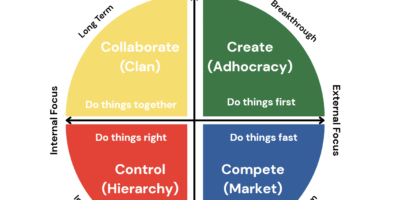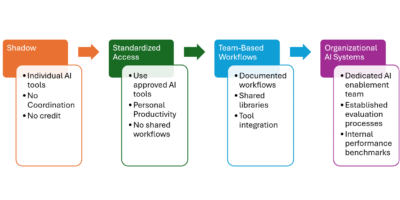Business agility has become crucial for achieving a competitive advantage. Business agility is about an organization’s ability to rapidly adapt to market changes, respond quickly to evolving customer needs, and pivot strategies when circumstances shift. Organizations that master this capability achieve faster time to market, higher customer satisfaction, and stronger financial performance. Yet many agility initiatives fall short despite implementing popular frameworks like Scrum, Kanban, or SAFe.
The difference between success and disappointment isn’t the frameworks themselves. It’s understanding that business agility requires transforming how your entire organization operates, not just changing processes and tools.
Business agility expert Karim Harbott identified that successful agile organizations depend on six fundamental enablers: leadership, culture, structure, people, governance, and ways of working. This framework provides a roadmap for building organizations that thrive in uncertainty and maintain competitive advantage. To understand why this comprehensive approach is necessary, let’s first examine why most agile transformation attempts fall short.
Why Most Agile Transformations Fall Short
Most agile transformations fail because organizations treat them as process changes rather than organizational transformations. They implement new events, roles, and tools while leaving command-and-control leadership, risk-averse cultures, and rigid approval processes unchanged.
This creates a fundamental mismatch. Agile frameworks assume teams can make decisions quickly, experiment safely, and collaborate across boundaries. But these capabilities require supportive organizational systems that most traditional organizations lack.
The predictable result: teams get frustrated trying to be agile within systems designed for control and predictability. Leaders get disappointed when promised benefits don’t materialize. Eventually, organizations abandon their agile initiatives or settle for superficial changes that deliver minimal value.
To avoid this cycle of disappointment, organizations need a comprehensive approach that addresses the root causes of transformation failure. The 6 Enablers of Business Agility Framework provides exactly that, a systematic way to transform the organizational foundation that agile practices require to succeed.
The 6 Enablers of Business Agility Framework
1. Leadership Transformation

Traditional command-and-control leadership creates bottlenecks that slow decision-making when speed determines competitive advantage. In complex markets, leaders at the top cannot access all the information needed to make optimal decisions about customer needs, technical solutions, or market opportunities.
This reality drives the need for fundamental leadership transformation. Traditional managers must shift from directive to supportive leadership, from centralized to decentralized authority, and from managing work to creating conditions for team success. This means delegating decision-making authority to teams closest to customers and problems, enabling faster response times and more relevant solutions.
Key Leadership Practices:
- Decentralize decision-making to teams closest to problems and customers
- Move from directive management to servant leadership and mentoring
- Focus on outcomes and impact rather than activity metrics
2. Culture Change

Organizational culture represents the shared values, beliefs, and behaviors that determine how work actually gets done. It’s the difference between what policies say and how people really behave when making decisions, solving problems, and interacting with colleagues.
Many organizations struggle with cultures that create barriers to agility. When cultures prioritize error prevention over learning, individual achievement over collective accountability, and information control over transparency, they naturally produce rigid hierarchies, excessive approval processes, and risk-averse policies. Employees adapt to these cultural signals by focusing on avoiding mistakes, protecting their work, and staying quiet rather than challenging existing approaches.
These behaviors directly conflict with what agile approaches require: rapid experimentation, cross-team collaboration, and quick adaptation based on feedback. Agile organizations need cultures built on learning, collective accountability, and open communication to enable the behaviors that drive agility.
Culture change doesn’t happen by trying to change mindsets directly. Instead, it happens through changing the underlying systems and behaviors that create cultural experiences.
Leaders must consistently model new behaviors while creating policies and systems that reward learning, team outcomes, and customer value delivery. New behaviors create new experiences, which gradually shift values and culture over time.
Cultural Transformation Elements:
- Build psychological safety where employees can speak up and take calculated risks
- Encourage experimentation and learning from both success and failure
- Promote transparency in decision-making and information sharing
- Shift from individual competition to collaborative team incentives
3. Organizational Structure

Traditional organizational structures create functional silos that separate teams by specialty rather than organizing them around customer value delivery. This design forces teams to work in isolation, requiring extensive handoffs between departments to deliver complete solutions, which increases coordination overhead and delays delivery.
The solution requires fundamental structural redesign. Instead of organizing by function (marketing, engineering, sales), agile organizations organize around customer value streams: the complete flow of activities needed to deliver value to specific customer segments. This requires cross-functional teams that include all the skills needed to deliver complete solutions without requiring handoffs to other departments.
This structural shift creates networks of interconnected, autonomous teams that can respond quickly when customer needs or market conditions change. The flatter structure reduces approval layers and enables faster decision-making, but it requires high levels of trust and collaboration to function effectively.
Structural Approaches:
- Organize around customer value streams rather than functional departments
- Create cross-functional teams with end-to-end delivery capabilities
- Establish clear team boundaries while enabling seamless collaboration
- Flatten hierarchies and eliminate unnecessary approval layers
4. People Engagement

Most organizations apply industrial-era management approaches focused on compliance, standardization, and control. These approaches were designed to get people to follow orders and execute known processes efficiently. However, modern knowledge work like software product development requires creativity, initiative, and passion rather than obedience and diligence.
According to Daniel Pink’s research in “Drive,” knowledge workers are motivated by autonomy, mastery, and purpose rather than just job security and steady wages. Yet most management processes still focus on the industrial-era goals of compliance and control, creating a fundamental mismatch with what actually drives performance in knowledge work. This mismatch leads to widespread employee disengagement.
The scale of this engagement problem is significant. According to Gallup’s 2024 State of the Global Workplace report, only 21% of employees worldwide are engaged in their work. This represents a massive waste of human potential that directly impacts organizational performance and agility.
Agile organizations must shift from managing for compliance to managing for engagement. This means providing clear purpose and connection to customer value, offering continuous growth opportunities, creating autonomy within appropriate boundaries, and implementing transparent advancement systems that treat people as responsible adults rather than resources to be controlled.
People-Centered Practices:
- Connect individual work to meaningful organizational purpose
- Offer continuous learning and skill development opportunities
- Replace annual performance reviews with continuous coaching and feedback
- Provide autonomy with clear expectations and accountability
- Implement transparent career progression and compensation systems
5. Governance and Funding Innovation

Waterfall-based governance models requiring extensive upfront analysis, detailed business cases, strict change control, and large batch funding are not designed for agility because they assume predictability in an unpredictable world.
This approach forces organizations to make major resource commitments based on incomplete information, creating waste when inevitable changes require expensive course corrections. The longer organizations wait to test their assumptions, the more likely they are to build solutions that no longer match customer needs or market conditions.
Organizations need governance approaches that work with uncertainty rather than against it. Agile governance acknowledges that assumptions will be wrong and creates mechanisms for fast learning and course correction. Instead of trying to predict the future, it enables small experiments that quickly validate or invalidate key assumptions.
Modern governance practices shift from large, risky bets to portfolios of small experiments. This approach reduces waste from failed projects, accelerates time-to-value through earlier validation, and optimizes resource allocation based on real market feedback rather than assumptions.
Governance Components:
- Shift from project-based to product-based funding models
- Create investment portfolios with small bets and iterative validation
- Focus on business outcomes rather than detailed upfront specifications
- Implement rapid feedback loops and agile decision-making cycles
6. Agile Ways of Working

Most organizations focus exclusively on implementing frameworks like Scrum, Kanban, or SAFe while leaving underlying organizational systems unchanged. This creates frustration and disappointing results because as we’ve seen, these frameworks require supportive leadership, culture, structure, people practices, and governance to function effectively.
Without the foundational enablers in place, teams struggle to deliver the promised benefits of agile frameworks. They may follow the events and use the tools, but they cannot achieve the speed, quality, and responsiveness that agile approaches are designed to deliver.
The solution is to recognize that ways of working require supportive organizational conditions to be effective. When leadership supports autonomy, culture encourages experimentation, structure enables collaboration, people are engaged, and governance allows fast learning, then teams can achieve the intended benefits of agile frameworks.
With the right organizational foundation, teams can effectively use agile frameworks to deliver customer value quickly, respond to market changes, and continuously improve their approaches based on feedback and learning.
Regardless of which specific framework teams adopt, certain underlying practices consistently drive effectiveness:
Effective Agile Practices:
- Visualize work to create transparency around progress and bottlenecks
- Focus on outcomes and value delivered rather than outputs and activities
- Foster self-organizing and cross-functional teams that communicate and collaborate through physical proximity and collaboration tools
- Work in small batches with short cycles to deliver more frequently and increase feedback loops
- Build in slack time for creativity, innovation, and learning
- Allow teams to own and continuously improve their own processes
How the 6 Enablers Work Together

These enablers function as an integrated system where each element influences and depends on the others. Leadership behavior shapes organizational culture, which in turn influences how structures are designed and how people experience work. Structure affects team collaboration and individual engagement levels. People engagement determines how effectively teams can use agile ways of working. Governance and funding mechanisms either reinforce or undermine all these transformational changes.
When the enablers are aligned, they create a reinforcing cycle that accelerates agility. When they’re misaligned, they create friction and resistance that slows progress. This is why organizations cannot successfully transform by focusing on just one or two enablers while ignoring the others.
Successful transformation requires changes that are consciously designed, coherent, and coordinated across all six domains. Organizations that skip enablers or treat them as independent initiatives typically fail to achieve meaningful change.
Business Case for Comprehensive Transformation
Many leaders question whether addressing all six enablers is worth the investment, especially when they could focus on just one or two areas that seem most urgent. This partial approach feels more manageable and less disruptive.
However, organizations that attempt partial transformations typically see limited results that don’t justify the effort invested. A leadership initiative without cultural support creates frustrated managers. Structural changes without engaged people lead to compliance without commitment. New governance models without supportive culture revert to old patterns under pressure.
The interconnected nature of the enablers means that progress in one area amplifies progress in others, while gaps in any area limit the benefits of improvements elsewhere. Organizations that commit to comprehensive transformation create compounding returns where each enabler reinforces the others.
The investment required is significant, but so is the competitive advantage gained. Organizations with aligned enablers can respond to market changes in weeks rather than months, launch new products faster than competitors, and attract top talent who want to work in high-performing environments.
Implementation Strategy
Begin by conducting comprehensive assessment of your organization’s current state across all six enablers. Identify which areas represent the biggest constraints to organizational agility and which changes would create the most significant positive impact.
Focus on creating coherent change initiatives that address multiple enablers simultaneously rather than tackling them sequentially. Use strategic tools like the Business Agility Canvas to visualize the current state, desired future state, and transformation roadmap required to bridge the gap.
Commit to the long-term nature of this organizational transformation. Building true business agility requires sustained effort and investment across all six enablers, but organizations making this commitment position themselves to thrive in increasingly uncertain and competitive marketplaces.
For leaders looking to understand how to orchestrate this integrated approach, our Building High-Performing Organizations Workshop provides practical guidance on aligning all six enablers for maximum impact.
Frequently Asked Questions
Why doesn’t implementing Scrum alone make our organization agile?
Scrum assumes organizational conditions that most traditional organizations don’t have: empowered teams, supportive leadership, collaborative culture, and flexible governance. Without these foundational elements, teams may follow Scrum ceremonies but can’t achieve the speed, quality, and responsiveness that agile approaches are designed to deliver. The framework requires a supportive organizational operating system to function effectively.
What’s the difference between business agility and just implementing Scrum or Kanban?
Business agility requires transforming how your entire organization operates, while Scrum and Kanban are just tools that teams use. Without supportive leadership, culture, structure, people engagement, and governance, these frameworks will struggle to deliver their intended benefits. The frameworks require organizational conditions that most traditional organizations don’t have.
How do you know if your organization is ready for comprehensive transformation?
Look for signs that current approaches aren’t delivering expected results: agile initiatives that start strong but fade over time, teams that follow agile events and roles but don’t achieve speed or quality improvements, or leadership frustration with the pace of change. These indicate that underlying organizational systems need transformation, not just new processes.
Why does this framework focus on organizational systems rather than individual skills?
Individual agile skills are important, but they can’t overcome systemic barriers. An engaged, skilled team will still struggle in a command-and-control culture with rigid approval processes. The framework addresses the organizational operating system that determines whether individual capabilities can be effectively applied.
What’s the biggest mistake organizations make when trying to become more agile?
Treating agility as a process change rather than an organizational transformation. They implement new roles and tools while leaving command-and-control leadership, risk-averse cultures, and rigid approval processes unchanged. This creates frustration without delivering the promised benefits of increased speed and responsiveness.
Related Resources
Leadership Development:
- Leadership Agility in a VUCA World – Understanding leadership challenges in volatile, uncertain environments
- The 3 Leadership Styles That Separate Great Leaders from Average Ones – Learn Expert, Achiever, and Catalyst leadership levels
Team Performance:
- The High-Performing Team Canvas – Practical tool for building effective cross-functional teams
Workshops & Implementation:
- Building High-Performing Teams Workshop – Hands-on training for team development
- Developing Future Leaders Workshop – Individual leadership development and growth



